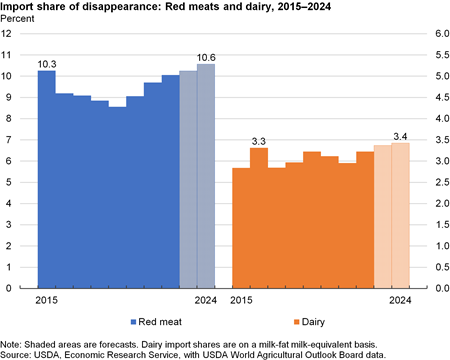Source: USDA
Summary
Beef/Cattle: Based on slaughter data through early December, higher cow slaughter and heavier-than-assumed carcass weights are expected to offset lower fed cattle slaughter in the fourth quarter of 2023, leaving the beef production forecast for 2023 unchanged. Expected heavier carcasses are carried over into early 2024, along with higher cow slaughter. Greater expected placements in late 2023 are also expected to add to a higher rate of fed cattle marketings in the second and third quarters of 2024. This raised the outlook for beef production in 2024 to 25.990 billion pounds. Projections for cattle prices are lowered on higher forecast production and weaker expected demand. For fourth-quarter 2023, expectations for beef imports are raised but exports are lowered. In 2024, the import forecast is raised, but exports are left unchanged from last month.
Import Shares of Domestic Use for Red Meats and Dairy
The figure below represents the percentage of annual domestic use, or disappearance, that was imported for red meats and dairy in 2015 through 2022 and is forecast for 2023 and 2024. These shares are calculated by dividing annual imports by annual domestic disappearance, which USDA calculates as a residual measure of supply (the sum of production, beginning stocks, and imports minus the sum of exports and ending stocks) that is used on the domestic market. Dairy disappearance is represented as domestic commercial use on a milk-fat milk-equivalent basis.
The red meat category is heavily influenced by the effects of beef imports, which in 2018–22 accounted for nearly 70 percent of total red meat imports, followed by pork (23 percent) and lamb (7 percent). The share of beef imports to domestic use has increased since 2019 on strong domestic demand and lower production and is projected to rise to a record level in 2024. In 2024, the share of imports to domestic use for beef will reach a record 13.7 percent, pork will be relatively flat at 5.5 percent, and the share of lamb imports is expected to rebound in 2024 to 71.9, its highest portion of domestic use since 2022. The dairy shares of imports on a milk-fat milk-equivalent basis are expected be about 3.4 percent in 2023 and 2024, which is higher than the 5-year average due to higher expected imports of products with relatively high milk-fat content.









